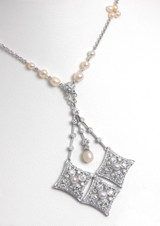An Introduction to Edwardian Style Vintage Jewellery

An Introduction to Edwardian Style Vintage Jewellery
From 1901 to 1910, King Edward VII adorned the royal throne in Britain. Known as the Edwardian era, it was the last jewellery period to be defined by a monarch. King Edward’s reign began at the beginning of the 20th century. The world was changing and a new era was sweeping through the land. This change is reflected in the jewellery trends of the time.
How It Was Made
The reign of King Edward VII is best known for its use of filigree techniques. Jewellery makers would thread gold, platinum and other metals to the surface of their settings. This would give the jewellery a unique, lacy look. During this period, the technique millegraining was created. This is a tiny beaded detail that finishes off a piece. The technique was frequently used with platinum, which was popular in Edwardian jewellery. All jewellery was handmade by designers as the techniques employed couldn’t be manufactured with machinery.
A Movement is Born
As the Edwardian era began to permeate society, two other movements began to surface. Specifically, Art Nouveau and arts and crafts aesthetics came to prominence.
The arts and crafts movement came about due to designers rejecting the industrialisation of goods. They preferred the simplicity of good craftsmanship and saw the industrial manufacturing of goods as devaluing the product. Handmade items were the hallmark of the movement.
Art Nouveau or new art was also prominent during the Edwardian era. Known as a total art movement, it embraced decorative arts, one of which was jewellery. The philosophy of the movement was that it should be a way of life. Many wealthy Europeans could live off an Art Nouveau lifestyle but by the end of 1910, the movement was out of style.
The Edwardian era was one of simplicity and elegance. Handcrafted items were in high demand and the industrialisation of goods diminished their value.
Edwardian Jewellery
Edwardian jewellery was manufactured for both the upper and middle class in Britain. It was designed to convey femininity and decorum. Designers preferred simple, classic motifs. The jewellery that appealed most to consumers included:
- Tiaras – a symbol of wealth, tiaras were elaborate and large, but not heavy to wear.
- Rings – Rings were often the same bow and garland motif with large centre stones and small diamonds. Rings were stacked and women wore multiple rings on a finger.
- Necklaces/Chokers – Referred to as dog collars, they first came to prominence in France in 1865. These tight-fitting necklaces were made from pierced platinum and black velvet.
Each of these pieces was elegantly made to insinuate the femininity of the jewellery. Platinum was the prominent metal for adding the finishing touches to jewellery as it conveyed both a feminine touch and a classic, elegant look.
As a vintage jeweller, we come across unique jewellery and accessories from every period. If you would like to learn more about our vintage collection, contact us today. Our representatives will happily discuss the perfect item for you to suit any price range.
